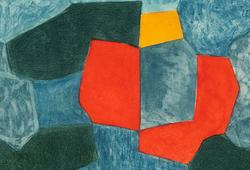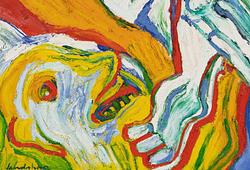Anders Zorn
"Italienska gatumusikanter"
Signed L. Zorn and dated -82. Watercolour, image 39 x 25.5 cm.
Provenance
The Dudley Art Gallery, London, 1883.
Private collection, England.
Thence by descent within the family.
Phillips, New York, 1992.
Private Collection, Sweden.
Exhibitions
The Dudley Art Gallery, London, 1883.
Zorn Museum, Mora, 1995.
Zorn Museum, Mora, "Anders Zorn och Musiken", 1 July - 14 September 2006.
Literature
Gerda Boëthius, "ZORN. The draughtsman. The painter. The etcher. The sculptor", 1949, mentioned p. 113 and listed in the catalogue under the year 1882 p. 539.
Antik & Auktion, June1993, mentioned p. 71.
Hans Henrik Brummer, "For the delight of the eye and the nation's embellishment - Anders Zorn", 1994, illustrated in colour, p. 61 and mentioned in the chronology p. 288.
More information
"Then I took the first train to Rome, another destination of longing, where I found compatriots and older friends [...] There were Skånberg, Pauli, Hammar, and other artists from Sweden, with whom I spent a pleasant month. The wonderful treasures of art and cultural-historical memories that Rome is so rich in, I still did not have the means to understand and enjoy. I saw many originals in marble of the plaster casts I had drawn at the Academy, and I certainly tried to get some decent compatriot to teach and interest me in the history of Rome as we wandered among the ruins of ancient Rome, but still, the living life and people occupied my mind."
So wrote Anders Zorn about his stay in Italy in the spring of 1882. He seems to have enjoyed himself in Italy, where he, along with Skånberg, made "pleasant excursions into the countryside, wandering about in osterias and not at all thinking about tomorrow." There has been discussion about whether Zorn actually executed the work in Italy or if it was completed in London based on sketches from his time in Italy. According to Gerda Boëthius, the work may also have been executed in London in 1883 and would then depict a street scene in Soho. However, this is contradicted by another account claiming that it is signed in London in October 1882.
Zorn sold "Italian Street Musicians" in 1883 at Dudley Art Gallery in London for £27, and it then passed down within the buyer's family. It was not until 1992 that the painting reappeared at an auction house in London. The seller was then a young schoolgirl who had no knowledge of Anders Zorn's artistry or the value of the work.
Artist
Anders Zorn, born in Mora in 1860, showed artistic talent from a young age. In 1875, he traveled to Stockholm and became a student at the then Slöjdskolan (now Tekniska högskolan) in Stockholm, and shortly after, he joined the Royal Academy of Fine Arts. Initially, Zorn had aspirations of becoming a sculptor, but soon watercolor painting took over, becoming his primary medium until 1887. At the student exhibition in 1880, Zorn had his breakthrough with the watercolor painting "I sorg." The following year, he gained international acclaim as a portrait painter. His watercolor painting reached its pinnacle during this period, and his most famous work from this time is "Vårt dagliga bröd” from 1886. Shortly thereafter, Zorn transitioned to oil painting, which was met with immediate success. Zorn's reputation mainly rested on his portrait art, and he portrayed many notable figures, including presidents. For instance, he created an etching of Theodore Roosevelt. His etchings significantly contributed to his success. In the late 1880s, Zorn began working in the genre that would increasingly become his trademark: nude figures in outdoor settings. He had long been fascinated by the movement of water and the reflections of light on its surface. Now, he added the complexity of placing a model near or in the water, aiming to depict a synthesis between nature and humanity. In 1896, Zorn and his wife moved back to Sweden and settled in Zorngården in Mora. This move sparked a renewed interest in his homeland, which would be reflected in his future paintings. Among the artist's scenes from the Mora region, portraying its local customs and ancient traditions, "Midsommardansen" holds the highest value according to Zorn himself. Today, the painting can be found at the National Museum.
Read more









































